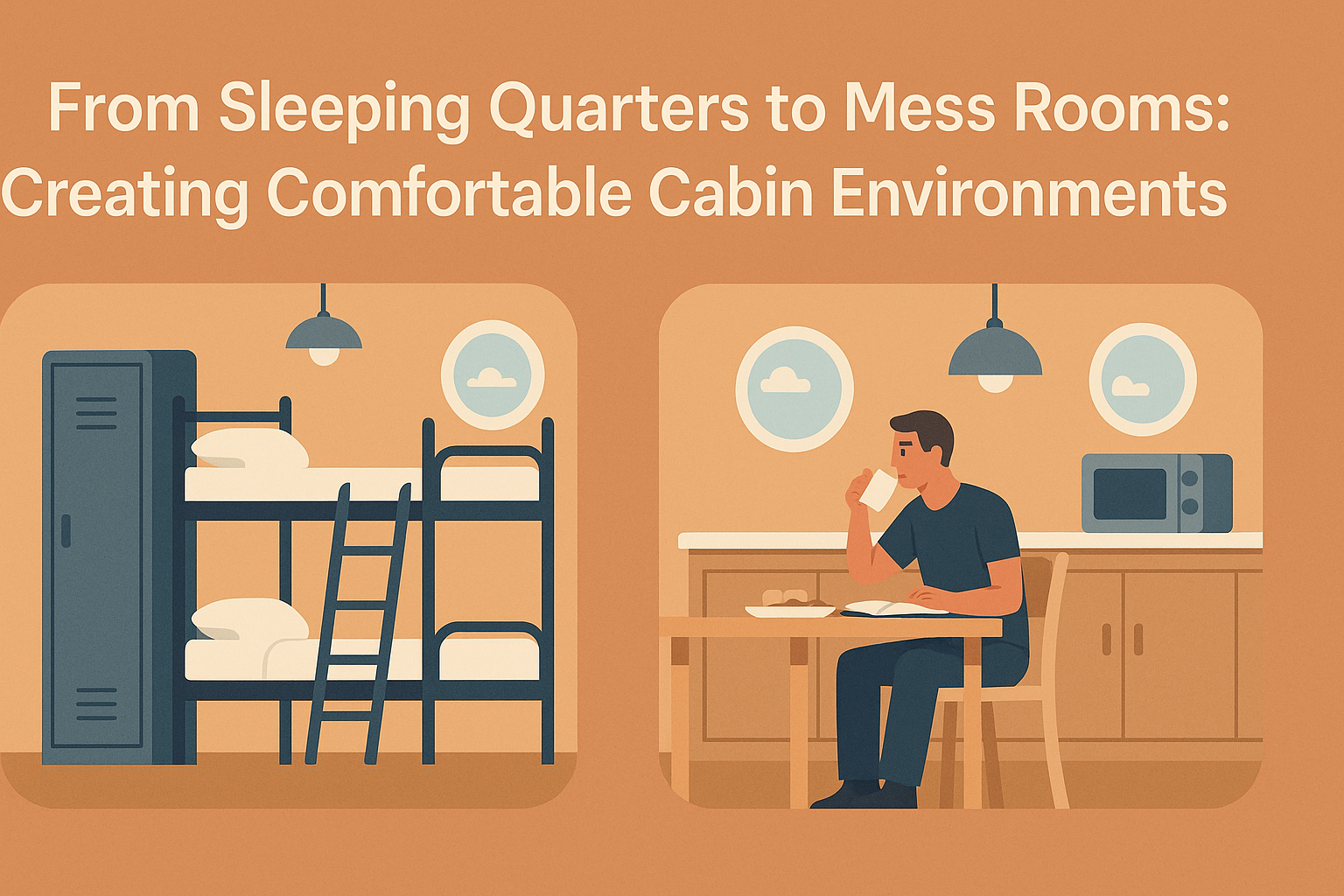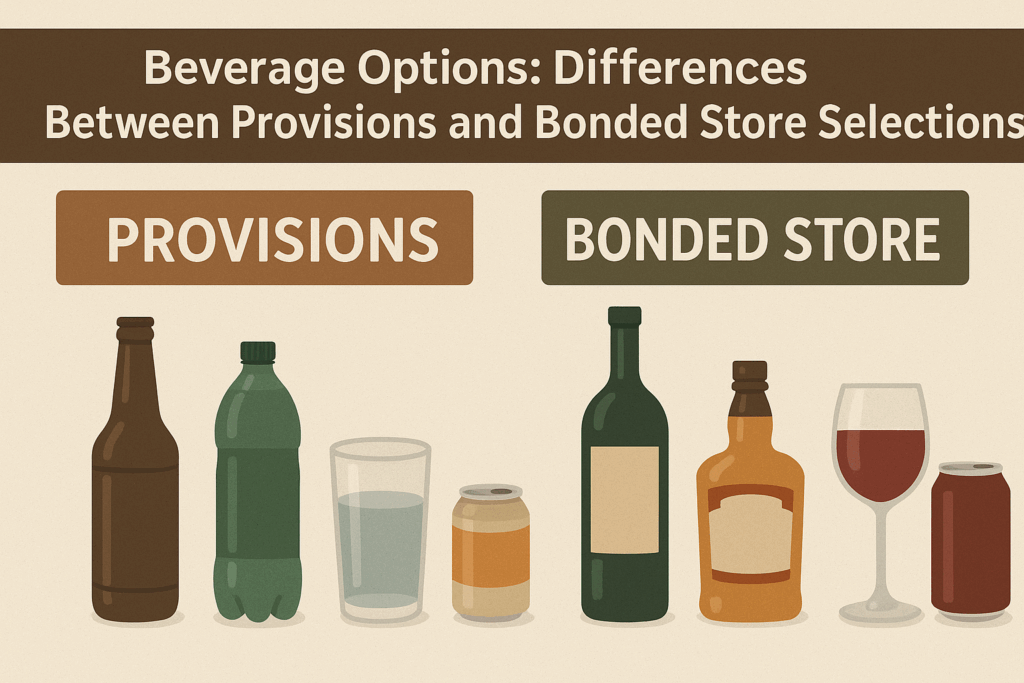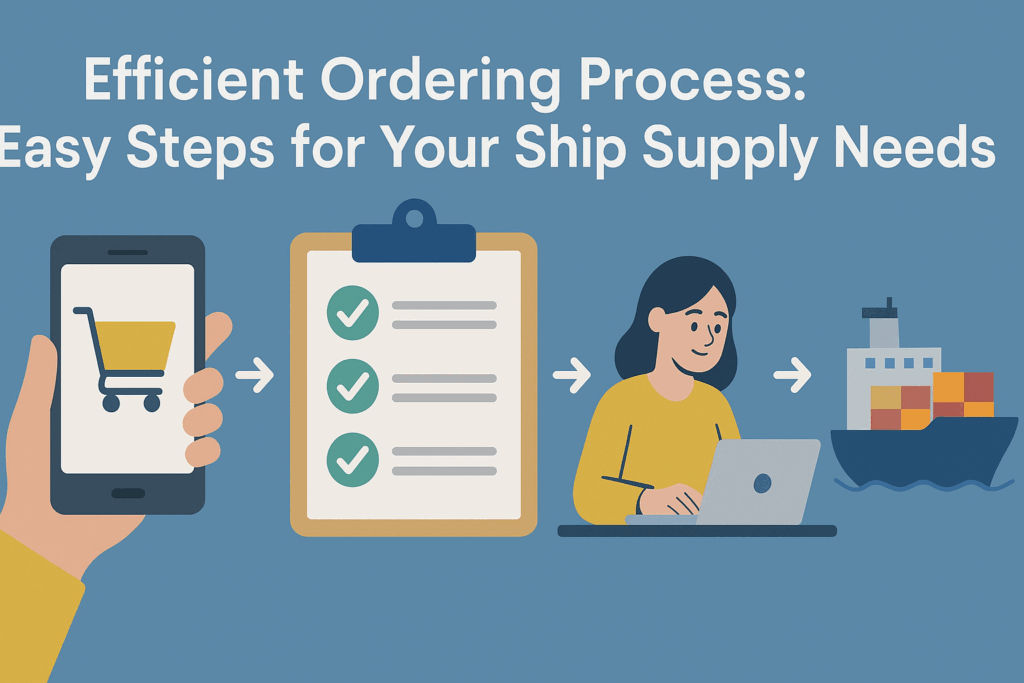Why Comfortable Cabins are No Longer a Luxury, But a Necessity
Life at sea presents unique challenges. Long voyages, demanding schedules, and separation from home mean that the onboard living environment significantly impacts crew morale, well-being, and ultimately, operational efficiency. Gone are the days when basic bunks and functional mess halls were deemed sufficient. Today, creating comfortable, safe, and restorative cabin environments – from sleeping quarters to mess rooms – is a critical investment in your most valuable asset: your crew. It’s not just about comfort; it’s about performance, safety, and retention in an increasingly competitive maritime industry.
Prioritizing high-quality cabin and accommodation supplies directly translates to tangible benefits, fostering a positive atmosphere that encourages loyalty and reduces fatigue-related risks.
The Foundational Pillars: Impact on Crew Welfare and Operations
Investing in superior cabin environments yields significant returns that extend far beyond simple aesthetics. Understanding these core benefits underscores the strategic importance of this aspect of ship management.
Enhancing Crew Retention and Recruitment
The quality of life onboard is a major factor for seafarers choosing contracts and remaining loyal to a company. Comfortable living spaces demonstrate that management values its crew. In a market where skilled seafarers are in demand, excellent accommodation can be a deciding factor, reducing costly turnover rates and attracting top talent.
- Better rest leads to higher job satisfaction.
- Well-designed spaces foster a sense of community and belonging.
- Positive word-of-mouth attracts new recruits.
Boosting Safety and Performance
Fatigue is a well-documented risk factor in maritime incidents. A restful cabin environment is crucial for ensuring crew members are alert, focused, and capable of performing their duties safely. Comfortable sleeping quarters promote restorative sleep, while pleasant mess rooms encourage proper breaks and nutrition intake.
- Reduced fatigue minimizes human error.
- Improved focus enhances operational precision.
- Better morale contributes to a stronger safety culture.
Meeting and Exceeding Standards
International regulations, notably the Maritime Labour Convention (MLC, 2006), set minimum standards for seafarer living conditions. While compliance is mandatory, aiming *above* these minimums demonstrates a commitment to excellence and crew welfare. High-quality furnishings and well-maintained spaces ensure you not only meet but exceed these requirements, enhancing your vessel’s reputation and operational integrity.
Designing for Rest: Optimizing Sleeping Quarters
The sleeping cabin is a seafarer’s personal sanctuary. Its design and furnishings should prioritize rest, privacy, and comfort to combat the stresses of life at sea.
Bedding and Mattresses: The Core of Comfort
A good night’s sleep starts with the right foundation. Investing in quality mattresses and bedding is paramount.
Key Considerations for Mattresses:
- Material: Options range from traditional spring mattresses to memory foam and hybrid models. Memory foam offers excellent pressure relief, while hybrids combine support and comfort. Consider materials resistant to mold and mildew in humid marine environments.
- Durability: Marine-grade mattresses are designed to withstand constant use and the motion of the vessel. Look for robust construction and high-density foams.
- Hygiene: Easily cleanable, hypoallergenic covers are essential. Waterproof or water-resistant properties add an extra layer of protection.
- Size & Support: Ensure mattresses provide adequate space and ergonomic support suitable for different body types.
Linens and Pillows:
Don’t overlook the details. High thread-count, breathable cotton or cotton-blend linens enhance comfort. Provide quality pillows that offer proper neck support. Having ample spares ensures bedding can be changed regularly, maintaining hygiene.
Lighting: Controlling the Ambiance
Proper lighting significantly affects sleep cycles and overall comfort.
- Adjustability: Individual berth lights allow crew members to read without disturbing roommates. Dimmable main lighting can create a more relaxing atmosphere in the evening.
- Blackout Capability: Effective blackout curtains or blinds are essential for day sleepers or navigating through different time zones, ensuring darkness regardless of the time.
- Natural Light: Where structurally possible, maximizing natural light during waking hours can improve mood, but control is key.
Noise Reduction: Engineering Tranquility
Noise from machinery, operations, or adjacent cabins can severely disrupt sleep. Effective noise dampening is crucial.
- Insulation: Quality insulation in bulkheads and decks minimizes sound transmission.
- Layout: Strategically locating sleeping quarters away from high-noise areas (engine room, galley) during the design phase is ideal.
- Furnishings: Soft furnishings like curtains and rugs can help absorb ambient noise.
Smart Storage Solutions: Maximizing Personal Space
Adequate and well-organized storage prevents clutter and makes small spaces feel larger and more functional.
- Vertical Space: Utilize wall-mounted shelves and tall lockers.
- Under-Bed Storage: Drawers or containers designed for under-bunk storage are highly efficient.
- Personal Lockers: Ensure secure storage for personal belongings.
The Social Hub: Creating Functional and Inviting Mess Rooms
The mess room is more than just a place to eat; it’s a vital social space where crew members relax, interact, and recharge. Its design should foster comfort and community.
Ergonomics and Layout Flow
A well-planned layout ensures functionality and comfort during meal times and breaks.
- Seating: Provide comfortable, durable chairs and appropriately sized tables. Consider booth seating for space efficiency and a cozier feel. Ensure adequate spacing for easy movement.
- Traffic Flow: Design the layout to avoid bottlenecks, especially around serving areas and exits.
- Surface Materials: Choose surfaces for tables and counters that are durable, non-porous, stain-resistant, and easy to sanitize – crucial for hygiene.
Atmosphere and Amenities
Creating a welcoming atmosphere encourages crew to utilize the space for relaxation.
- Lighting: Unlike cabins, mess rooms benefit from brighter, warmer lighting to create an inviting ambiance. Task lighting over serving areas can be beneficial.
- Refreshment Access: Easy access to beverage stations (coffee, tea, water) is essential. Consider placement of refrigerators or vending machines for snacks if appropriate (related to Provisions & Food Supply).
- Entertainment: A television, access to news, or even board games can enhance the mess room as a recreational space.
Hygiene and Maintenance Focus
Maintaining high standards of cleanliness is non-negotiable in food consumption areas.
- Cleaning Schedules: Implement and adhere to rigorous cleaning protocols.
- Waste Management: Provide clearly marked and sufficient waste receptacles.
- Supply Availability: Ensure cleaning supplies are readily available for immediate spill cleanup.
Beyond the Essentials: Enhancing Common Areas
While sleeping quarters and mess rooms are primary, other accommodation aspects contribute to overall well-being.
- Recreation Rooms: Dedicated spaces with amenities like exercise equipment, libraries, or movie areas significantly boost morale.
- Connectivity: Reliable and affordable internet access is increasingly expected by seafarers to stay connected with family.
- Sanitary Facilities: Clean, well-maintained, and private bathroom facilities are fundamental.
- Laundry Facilities: Efficient and sufficient washing and drying machines are essential practicalities.
Astro Ship Supply: Your Partner in Superior Cabin Environments
Achieving optimal cabin comfort requires not just planning, but access to high-quality, durable, and compliant supplies. At Astro Ship Supply, we understand the unique demands of the maritime environment. We specialize in providing comprehensive cabin and accommodation solutions tailored to your vessel’s needs and your crew’s well-being.
From marine-grade mattresses and comfortable bedding to durable mess room furniture and essential amenities, we source and deliver products that meet stringent quality controls and maritime standards. Our commitment ensures your vessel is equipped not just for compliance, but for comfort and crew satisfaction. We help you source:
- Mattresses, Pillows, and Linens
- Cabin Furniture (bunks, lockers, chairs, tables)
- Mess Room Furnishings
- Galley and Mess Utensils
- Cleaning Supplies and Janitorial Equipment
- Personal Protective Equipment (PPE) holders and storage
Our operations comply with ISO 9001:2015 and HACCP standards, ensuring quality and safety in every delivery across the Port of Houston and the Gulf Coast region.
Case Scenario: The ‘Odyssey’ Crew Morale Turnaround
Consider the M/V Odyssey, a vessel experiencing high crew turnover and frequent complaints about living conditions. Feedback highlighted lumpy mattresses, poor lighting in cabins causing eye strain, and a cramped, uninviting mess hall. Management partnered with a quality ship supplier to overhaul the accommodation.
Actions Taken:
- Replaced all cabin mattresses with high-density foam, marine-grade options.
- Installed individual, adjustable LED berth lights and blackout curtains in all sleeping quarters.
- Reconfigured the mess room layout for better flow, adding comfortable booth seating and brighter, warmer overhead lighting.
- Upgraded tables with durable, easy-to-clean laminate surfaces.
- Ensured a consistent supply of fresh, quality linens.
Results: Within six months, crew satisfaction surveys showed a marked improvement. Feedback specifically mentioned better sleep quality and a more pleasant dining/social experience. Crew turnover decreased by 15% in the following year, demonstrating the direct link between investment in cabin comfort and crew retention.
Quotable Checklist: Essential Elements for Comfortable Cabin Environments
Use this list as a quick reference when evaluating or upgrading your vessel’s accommodation:
- ✅ **High-Quality Mattresses & Bedding:** Prioritize support, durability, and hygiene.
- ✅ **Effective Lighting Control:** Blend ambient, task, and blackout options.
- ✅ **Noise Dampening Measures:** Insulation and strategic layout are key.
- ✅ **Sufficient & Secure Personal Storage:** Reduce clutter, enhance personal space.
- ✅ **Ergonomic & Durable Mess Room Furniture:** Ensure comfort and longevity.
- ✅ **Clean, Well-Maintained Surfaces:** Critical for hygiene and morale.
- ✅ **Adequate Sanitary & Laundry Facilities:** Non-negotiable basics.
- ✅ **Reliable Access to Amenities:** Refreshments, recreation, connectivity.
- ✅ **Regular Maintenance Schedule:** Keep facilities in top condition.
- ✅ **Partnership with a Quality Supplier:** Ensure access to compliant and durable goods like those from Astro Ship Supply.
Frequently Asked Questions (FAQ) about Ship Cabin Environments
What are the key requirements of the MLC, 2006 regarding cabin accommodation?
The Maritime Labour Convention (MLC, 2006) sets minimum standards for sleeping rooms, mess rooms, and recreational facilities. Key aspects include minimum room sizes per person, adequate heating/ventilation, proper lighting, sufficient storage, quality bedding provided by the shipowner, and separation of sleeping quarters from noise-intensive areas like engine rooms and galleys. It also mandates clean, comfortable, and appropriately furnished mess rooms.
How often should ship mattresses and bedding be replaced?
There’s no single mandated frequency, but best practice and hygiene standards suggest regular assessment. Mattresses should be replaced when they show signs of wear, sagging, or damage, typically every 5-7 years, depending on quality and usage. High-quality marine-grade mattresses may last longer. Bedding (sheets, pillowcases) should be laundered frequently and replaced when worn, torn, or stained, usually on an annual or biennial budget cycle, ensuring ample spares are always available.
What is the single most important factor in mess room design?
While multiple factors are crucial (hygiene, layout, furniture), creating a **welcoming and comfortable atmosphere** is arguably paramount. The mess room serves a vital social function. If the space feels clinical, cramped, or unpleasant, crew members are less likely to use it for relaxation and social interaction, impacting morale. Comfort, good lighting, and cleanliness work together to achieve this welcoming feel.
How can we improve cabin comfort on a limited budget?
Focus on high-impact, lower-cost items first. Replacing worn-out bedding (pillows, linens) can make a significant difference. Ensuring effective blackout curtains are installed is relatively inexpensive but greatly improves sleep quality. Deep cleaning and decluttering common areas costs little but improves ambiance. Implementing a regular maintenance schedule for existing furniture and facilities prevents small issues from becoming large, costly ones. Prioritize replacing the most worn-out mattresses first, phasing upgrades over time.
Where can ship managers reliably source high-quality cabin supplies in the Houston and Gulf Coast region?
For vessels operating in the Port of Houston and the wider Gulf Coast region, partnering with a dedicated ship chandler like Astro Ship Supply ensures access to a comprehensive range of quality cabin and accommodation supplies. We offer everything from marine-grade mattresses and bedding to mess room furniture and amenities, all meeting maritime standards. You can explore our specific offerings on our Cabin & Accommodation services page or request a quote directly.






